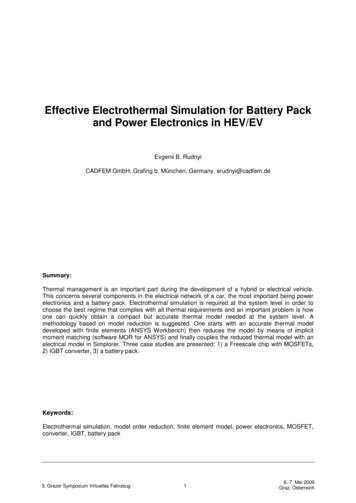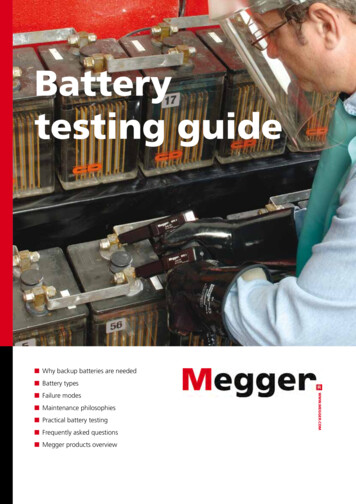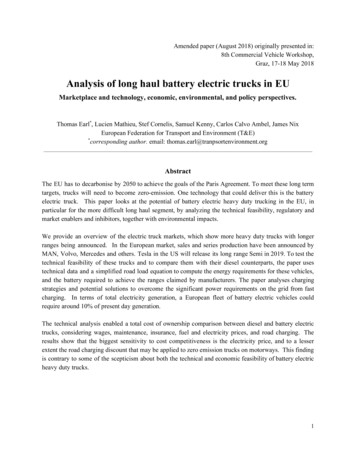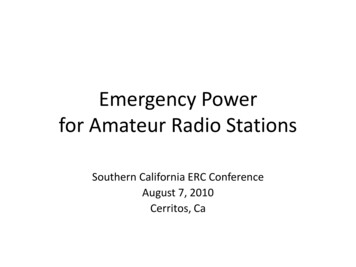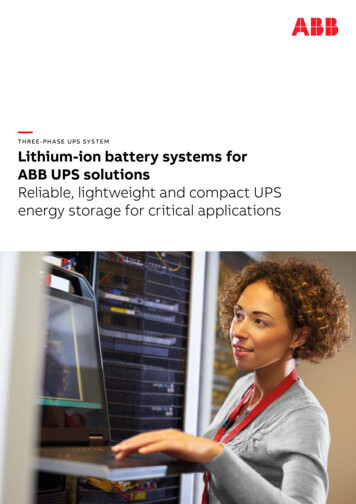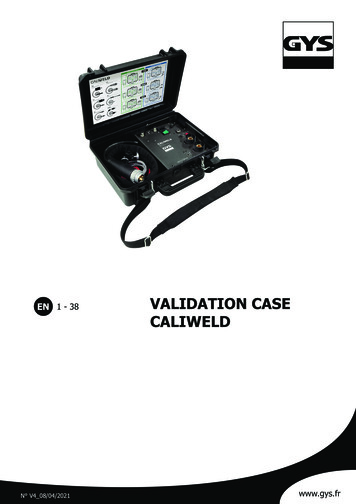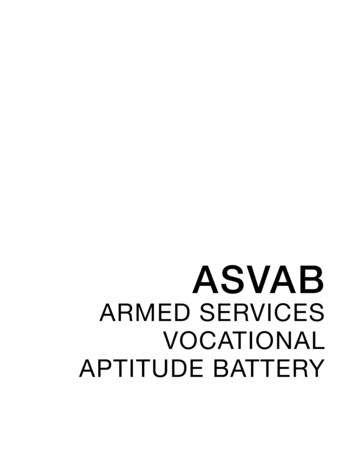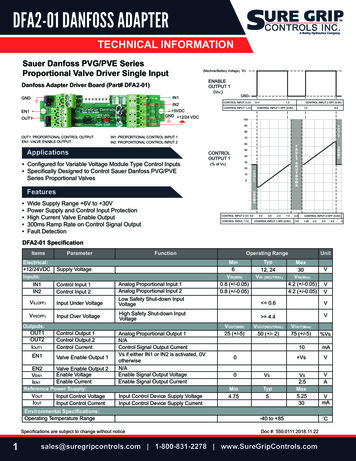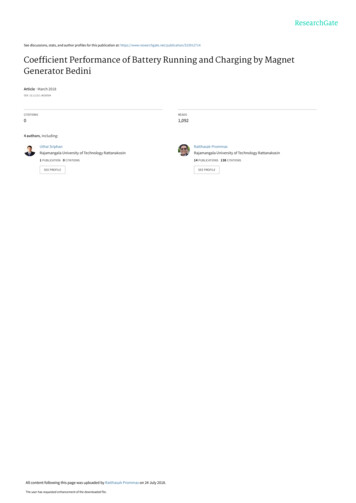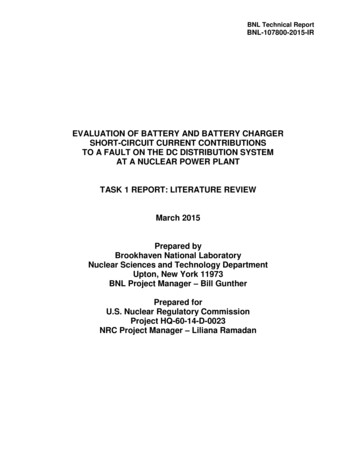
Transcription
BNL Technical ReportBNL-107800-2015-IREVALUATION OF BATTERY AND BATTERY CHARGERSHORT-CIRCUIT CURRENT CONTRIBUTIONSTO A FAULT ON THE DC DISTRIBUTION SYSTEMAT A NUCLEAR POWER PLANTTASK 1 REPORT: LITERATURE REVIEWMarch 2015Prepared byBrookhaven National LaboratoryNuclear Sciences and Technology DepartmentUpton, New York 11973BNL Project Manager – Bill GuntherPrepared forU.S. Nuclear Regulatory CommissionProject HQ-60-14-D-0023NRC Project Manager – Liliana Ramadan
BNL Technical ReportBNL-107800-2015-IRThis report was prepared as an account of work sponsored by an agency of the United StatesGovernment. Neither the United States Government nor any agency thereof, nor any of their employees,nor any of their contractors, subcontractors, or their employees, makes any warranty, express or implied,or assumes any legal liability or responsibility for the accuracy, completeness, or any third party’s use orthe results of such use of any information, apparatus, product, or process disclosed, or represents that itsuse would not infringe privately owned rights. Reference herein to any specific commercial product,process, or service by trade name, trademark, manufacturer, or otherwise, does not necessarily constituteor imply its endorsement, recommendation, or favoring by the United States Government or any agencythereof or its contractors or subcontractors. The views and opinions of authors expressed herein do notnecessarily state or reflect those of the United States Government or any agency thereof.
BNL Technical ReportBNL-107800-2015-IREXECUTIVE SUMMARYInherent in designing and maintaining short-circuit protection in a DC distribution systemprotection is knowing what the contributions are from the station battery and batterycharger(s), the major sources of direct current to a fault on the DC distribution system.There is an extensive amount of literature dealing with this subject in the form ofindustry guidance or standards, journal articles, and test reports. The purpose of thisBNL technical report is to review these sources and summarize the information that isrelevant to better understanding the expected contributions from batteries and batterychargers in response to a fault on a DC distribution system at a nuclear power plant.The review of the literature revealed several interesting factors associated with thisgeneral subject including:1. Industry guidance and standards (summarized in Table 1) differ somewhat withregard to the magnitude of the short-circuit currents to be expected from a ventedlead acid battery and the combined effect from the battery charger and batterywhen they are connected in parallel (the typical configuration for a nuclear powerplant). Some publications indicate that a conservative rule of thumb approach issufficient while others recommend more precise calculations that take intoaccount DC distribution system resistance and inductance.2. These same industry standards are based on a limited amount of testing andother empirical data. IEEE 141-1993 states that “Simplified procedures for thecalculation of DC short-circuit currents are not well established.” Since many ofthe DC distribution systems in the current commercial nuclear reactor fleet weredesigned before 1993, there may not have been a uniform approach taken tocalculating the expected contributions from battery chargers and batteries whendesigning the short-circuit protection schemes for the DC distribution system.3. Journal articles written on the subject over the past twenty years provide similarmethods to calculate short-circuit current contributions and provide approacheson how best to configure protection in a DC distribution system. The overall goalcited is to isolate the fault as close to the occurrence as possible in order tominimize the impact on other equipment and facility operations. Software hasbeen developed to assist with these calculations where the complexity of the DCdistribution system warrants it.4. The articles that describe testing that has been performed on vented lead acidcells and a battery charger show that the general rules of thumb for calculatingshort-circuit currents yield values that are higher than the actual fault current thatwill be realized. While the higher fault current values determined by using therules of thumb may be considered to be “conservative”, they may haveshortcomings when considering the overall system response to a fault condition.For example, a few articles discuss the potential for a cable fire if the protectionsettings are based on overly conservative (too high) settings that would increasethe fault interruption time.iii
BNL Technical ReportBNL-107800-2015-IR5. The rate of rise of the fault current (time constant in milliseconds) is dependenton the DC distribution circuit characteristics. According to the technical papersreviewed, knowledge of this time constant (which is a function of the circuitinductance) is important when selecting the settings of the protective devices.6. Plants that have increased the capacity of their battery strings in order toaccommodate the additional loads that have been added to the DC distributionsystem over the life of the plant may also need to upgrade their protectivedevices to ensure that their interruption ratings are satisfactory for the largerbattery fault current that will be produced.This report summarizes the information about the short-circuit currents associated withvented lead-acid batteries and battery chargers and categorizes the sources of thisinformation. No testing data were found where a short circuit was applied to a batteryand a battery charger in combination. The phase 3 work planned will therefore offernew information that should be useful to the NRC and the nuclear industry in general.iv
BNL Technical ReportBNL-107800-2015-IRTABLE OF CONTENTSEXECUTIVE SUMMARY . iiiI.a.b.II.INTRODUCTION . 1Objective: . 2Summary of Publications:. 2LITERATURE REVIEW SYNOPIS . 6a. Industry Standards . 6b. Journal Articles and Conference Proceedings – (Testing Related) . 17c. Journal Articles and Conference Proceedings – (Non-Testing Related) . 20d. Vendor Publications and Communications . 28III. DISCUSSION . 32a. Other Considerations . 32b. Battery Chargers in Use . 33IV. SUMMARY AND RECOMMENDATIONS . 35v
BNL Technical ReportBNL-107800-2015-IRLIST OF FIGURESPageFigure1:Sample dc one-line diagram from IEEE 399-1997.Figure 2:Excerpt from IEEE Standard 946-2004 . 13Figure 3:Example DC System for a Fault Study (EPRI TR-100248). 23Figure 4:Sample Battery Vendor Short-Circuit Data . 29Figure 5:Early Battery Response to a Short Circuit . 30vi8
BNL Technical ReportBNL-107800-2015-IRLIST OF TABLESPageTable 2:Summary of Industry Standards Information Related to DCSystem Faults . 16Table 2:300A SCR-Type Battery Charger Short-circuit Contributions:Summary of Testing Results . 17Table 3:Short-Circuit Test Results of an AT&T Battery(Excerpted from paper). 19Table 4:Battery Charger Types Used in Nuclear Power Plants (1994 Source) . 33Table 5:Class IE Battery Chargers- EPIX Database (2014) . 34vii
BNL Technical ReportBNL-107800-2015-IRviii
BNL Technical ReportBNL-107800-2015-IRI.INTRODUCTIONOn September 25, 2011 at the Palisades Nuclear Plant on the left train of DC power,both the battery charger and the battery tripped on overcurrent when a fault occurred onthe downstream DC panel (Information Notice 2013-17). As a result of the event, aSpecial Inspection Team (SIT) was assembled. The complete details of this event areprovided in the SIT Report (ADAMS Accession No. ML113330802). Page 47 of the SITreport, the following is states:According to Ametek, the manufacturer of the battery charger, the current-limitingfeature of the battery chargers were not immediate (38 millisecond time delay)and were not designed to protect against large, instantaneous DC faults.Because the fault current was very high, the battery charger tripped before thecurrent limiter was able to respond and compensate. This phenomenon was alsodiscussed in IEEE-946-2004, “IEEE Recommended Practice for the Design ofDC Auxiliary Power Systems for Generating Station.IEEE Standard 946-2004 Subclause 7.9.2 states: “When the battery charger isconnected in parallel with the battery, the battery capacitance will prevent the batterycharger contribution from rising instantaneously. Therefore the maximum current that acharger will deliver on short circuit will not typically exceed 150% of the charger full loadampere rating. Instantaneous battery charger current rise should only become aconcern during periods when the battery is disconnected.” The statements in IEEE 9462004 related to the nature of these contributions may be contrary to what actuallytranspired at the Palisades Plant in September 2011, although there remains someuncertainty about exactly what transpired during that event. Nevertheless, there is aneed to determine whether the individual short-circuit current contributions of a batteryand a battery charger are independent of each other in a typical nuclear power plant DCdistribution system configuration. This is necessary so that engineering measures suchas protective device coordination can limit the impacts of such an event. The NRC staffcurrently considers that the statement in IEEE Std. 946-2004, Subclause 7.9.2,“Instantaneous battery charger current rise should only become a concern duringperiods when the battery is disconnected,” is incorrect and is being applied erroneously.The staff believes that instantaneous battery charger current rise should be dependentonly on the battery charger design and not whether the battery is connected ordisconnected. Therefore, the battery charger short-circuit protection should take intoconsideration the initial short-circuit current rise during the first approximately100 milliseconds of the fault occurrence.The NRC issued Information Notice (IN) 2013-17 on September 6, 2013. This INdescribed the event that occurred at the Palisades Plant in September 2011 andencouraged licensees and applicants to review their design to insure that a fault similarto that which occurred at Palisades would not degrade the performance of their DCelectrical distribution system.1
BNL Technical ReportBNL-107800-2015-IRa.ObjectiveThe overall objective of this task is to conduct an extensive literature search thatincludes technical papers, reports of previous testing, and detailed information about dcpower distribution short-circuit protection, focusing on the contributions to a fault frombattery chargers and batteries. This BNL technical report documents the review andanalysis of these documents and provides recommendations for incorporating thisinformation into the short-circuit testing that will be conducted.b.Summary of PublicationsThe following publications (including email and correspondence) were reviewed and aredescribed in this report.Industry Standards:1. IEEE Standard 141-1993; IEEE Recommended Practice for Electric PowerDistribution for Industrial Plants; describes the importance of knowing themagnitude of available DC short-circuit current in the design and application ofprotective devices.2. IEEE Standard 242-2001; IEEE Recommended Practice for Protection andCoordination of Industrial and Commercial Power Systems; provides basics onthe nature of short-circuit currents and the process for establishing protectioncoordination.3. IEEE Standard 399-1997; IEEE Recommended Practice for Industrial andCommercial Power Systems Analysis; this recommended practice commonlyknown as the “Brown Book” is a general treatise on power systems analysistheory. The 1997 version of this Standard includes a new chapter entitled “DCauxiliary power systems analysis”.4. IEEE Standard 666-1991; IEEE Design Guide for Electric Power ServiceSystems for Generating Stations; Provides info a fault contributions frombatteries and battery chargers. Includes annexes with calculating short-circuitcurrents in a DC system.5. IEEE Standard 946-2004; IEEE Recommended Practice for the Design of DCAuxiliary Power Systems for Generating Stations; discusses the available shortcircuit current from batteries and battery chargers and contains several annexeson how to calculate the magnitude of these currents.6. IEEE Standard 1375-1998; IEEE Guide for the Protection of Stationary BatterySystems; this guide discusses the short-circuit characteristics of batteries andbattery chargers and provides guidance for the protection of battery systems.7. IEC Standard 61660; Short-circuit currents in dc auxiliary installations in powerplants and substations; Two volu
3. IEEE Standard 399-1997; IEEE Recommended Practice for Industrial and Commercial Power Systems Analysis; this recommended practice commonly known as the “Brown Book” is a general treatise on power systems analysis theory. The 1997 version of this Standard includes a new chapter entitled “DC auxiliary power systems analysis”.


